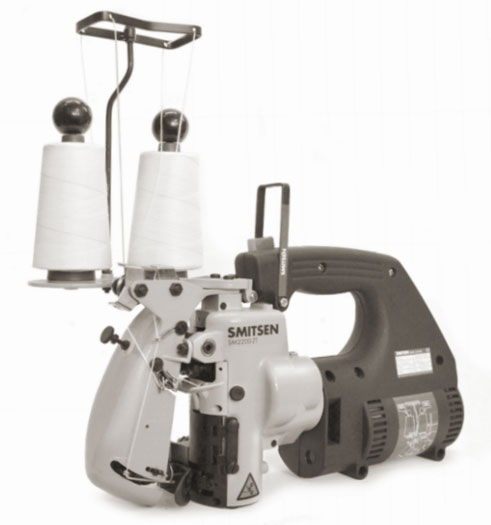 Smitsen 2200-2t (Double thread, Double feed Portable sewing machine)
Smitsen 2200-2t (Double thread, Double feed Portable sewing machine)
Troubleshooting checklist general
SM2200-2t specific:
Adjustments and settings.
Needle-looper distance and needle-guard adjustments can be made from the bottom of the machine after having removed the protection-plate with the holes (1 screw).
When a thin needle is replaced by a thick one (or reverse), the following adjustment has to be made:
Adjustment of the distance beween needle and looper (0,1 mm for a double stitch (2-thread) machine). Needle-looper adjustment is described here specifically, because it is a critical setting.
- When the machine has been threaded, remove only the wire from the needles eye, otherwise the wire will frustrate the adjustment process.
- ?Screw C? , as mentioned in the manual, located behind the plastic plug, has to be loosened before the looper-shaft can be moved in order to adjust the needle-looper distance.
- The shaft can travel a distance of 4-5 mm on the flat surface of the shaft. The screw is accessible in the folowing situation ONLY:
- When the looper is ABOVE the needle. This is the side where the needle-thread enters the needle-hole.
The 0,1 mm adjustment however, must be made when the looper is on the other side of the needle. So, reposition the loopershaft/looper by means of the motor-wheel. - When the loopershaft is pushed inwards, (towards the shaft-bushing), the looper/needle distance becomes wider. Pulling outwards, away from the bushing, makes the needle-looper distance smaller.
- The moment of measuring is when the point of the looper is in the centerline of the eye
Wheel-gear synchronisation when a motor has been replaced.
Check the timing of the wheels (gear). The timing is Ok when the lower feeddog has reached his maximum position,
going outwards. At that time the needle eye must be just visible (Is coming out of the needle-plate)
Experienced problems.
- Wrong threading of the machine.
- Too much margin in the looper shaft between the looper and the bushing.
- Bent feed dogs (the upper feed dog bents more often then the lower feed dog. A knocking or ticking sound is heard
- A knocking sound can also be heard if the looper hits the needle (wrong looper-adjustment, Looper, needle has to be adjusted)
- Wrong synchronization between Needle/Looper and feeddogs. Often the result after a motor-change, causing the 2 gears going out of sync
- Testing with paper must result in square holes without torn paper.
- Dirt under the needle-plate.
- Height of the needle is not correct. (The looper splits the thread instead of picking up the thread completely).
- The needle-retainer pushes the needle out of his position (adjustment isseu)
- A bent needle.
- The needle is not in the center of the needle-hole of the needle-plate. Often the result of a machine that has been dropped (bent arms) The machine is total loss in that case. (Replacing the arms is too costly in parts and time).
- Check if the needle-plate is broken. Often the result of pulling the machine through the fabric. (Let the machine do the transport through the fabric!!)
